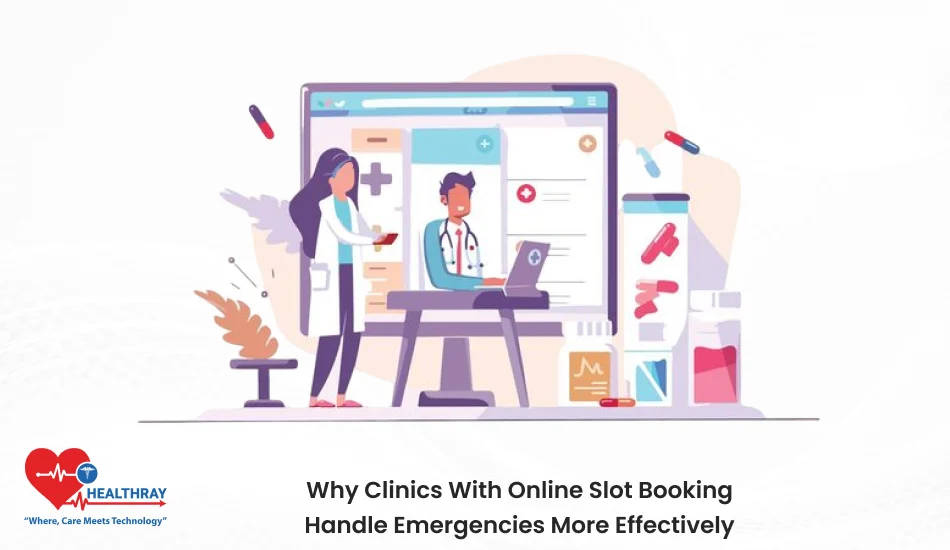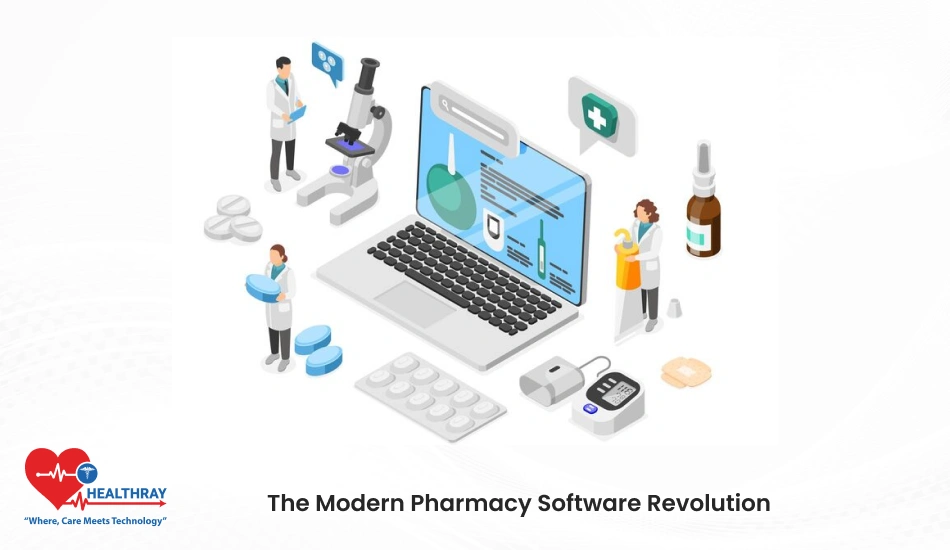Pharmacists will lead the change in healthcare that has been long overdue. A structured way to manage prescriptions, inventories, billing, and patient records is required. That is when a pharmacy management system comes onstage. It’s not merely a piece of software; it’s an enormous enabler of workflow, accuracy, and heightened patient care.
The Pharmacy Management System automates all day-to-day routines, facilitates faster progression in business processes, and also connects healthcare professionals and pharmacologists to the patients. Automation is not the only thing; it provides an easily connected, patient-friendly orientation to healthcare delivery.
This blog post briefs readers on how this software is influencing all the above health professionals, pharmacy managers, software developers, and hospital administrators. Patient outcomes, reduced errors, and improvements in efficiencies-all have something here for them.
More Understandable Pharmacy Management Software

This is far called a digitization upgrade in pharmacies. It’s the software that would lead the change in the way pharmacies do things. It is designed chiefly to take care of daily tasks like processing prescriptions, tracking inventories, billing, and even maintaining patient records. But as I said, there is a lot more to it.
This is what it will do for you:
- Automation of Repetitive Tasks: Manual work is high-time consuming and with increased chances for mistakes. The pharmacy management software automates these repetitive tasks by refilling prescriptions or bringing up-to-date records of inventory levels. This saves a common resource time and utilizes it for value additions to the care of patients.
- Improved Patient Safety: The risk of prescribing error is substantially reduced by tracking medication histories for a patient and anything else noted that would signify possible drug interactions. This makes the environment safer for patients while empowering healthcare providers with their recommendations.
- Seamless Integration: New-age pharmacy software would have built-in interface with other healthcare systems with electronic medical records (EMRs) and billing platforms. This seamless connectivity keeps the information flowing without tangles through doctors, pharmacies, and patients.
- Regulatory Compliance: With the stringent regulations that pharmacies are molded around concerning controlled substances, data security, and reports, the software, with built-in compliance tools, could assist pharmacies in adhering to these standards without a corresponding increase in administrative burden.
This thus creates the foundation from which to discuss the impact of pharmacy management software on various stakeholders in healthcare. Each of these adopts a different view: healthcare professionals, pharmacy managers, software developers, and hospital administrators-all have something new and different to gain from these systems. .
Let’s Comprehend How Pharmacy Manager Software Affect Stakeholders
Advantages for Healthcare Professionals
Healthcare professionals are the primary contacts of patients, and pharmacy management software is an important tool that helps to facilitate their work. It links pharmacists, doctors, and the patient for better outcomes and easier processes. Here’s how it helps:
Real Time Access to Medication Histories
What happens when a doctor attempts to write a prescription using an incomplete medication record of a patient? Well, then there’s no need to guess because, with the software, an up-to-date medication history-the most complete possible under the circumstances-is provided. Using this, the risk of adverse drug interactions can be reduced, leading to a greater safety and reliability of prescriptions.
Boosting Communication to Pharmacists
A pharmacy management software solution integrates with electronic health records (EHRs) for real-time communication between health care practitioners and pharmacies. Physicians can electronically send prescriptions, removing the pitfalls of handwriting errors or lost in translation issues.
Better Insights for Decision-Making
Advanced systems offer analytics and reporting features. These tools help healthcare professionals monitor patient compliance with medications and spot trends that may require adjustments to treatment plans.
Enhanced Patient Trust
Accuracy and safety through technology can help build the trust of patients with healthcare professionals. Patients take confidence in the care they receive when they know their doctor, or pharmacist uses the latest tools.
Prescribing medication is not all that this software can do; it creates an environment properly oriented towards collaboration between healthcare professionals and pharmacists for the patient’s benefit. Both patients and providers win in this setup.
Advantages for Pharmacy Managers
Pharmacy managers are squeezed from all sides, managing the seamless day-to-day operations, ensuring regulatory compliance, and juggling many other demands. Status quo simplification using PMS System makes all operations more efficient and gives pharmacy managers time to attend to their strategic priorities. The following list highlights some benefits to pharmacy managers:
Procurement Simplified
Managing stock, keeping prescriptions updated and maintaining billing records could take a lot of time. The software brings this whole process under one umbrella, automated to free up repetitive work time to focus on strategy. Fewer disruptions result in smoother workflows.
Enhanced Inventory Control
Pharmacies face the twin bastions of overstocking and not stocking at all. Management software provides real-time inventory tracking, sets alerts for lowest-stock items, and forecasts demand from trends and patterns of usage data. This keeps the right medicines in stock.
Easy Regulation Conformity
Pharmacies operate in a very tightly regulated environment. The software would ensure compliance with the legal requirements through keeping records accurate, compiling reports, and ensuring that sensitive data are protected. This is less indeed of risk concerning fines or other penalties.
Enhanced Patient Services
Fulfilling routine tasks through automated processes allows the pharmacist to devote more time for patient consultations and personalized care, enhancing the reputation and adding to the profitability of a pharmacy and, presumably, customer satisfaction.
Data-Driven Insights
Through the provision of analytics tools through pharmacy management system services, managers are better able to monitor trends, strategies applied to pricing, and informed decisions on staffing or purchases regarding inventory.
The system is not a tool; it is an enabler that makes pharmacy managers confident and effective at handling challenges.
Opportunities for Software Developers
This is the way pharmacy management software has such great potential for software developers who want to innovate solutions for healthcare. With growing demand for ubiquitous, easy-to-use, and secure solutions, developers play a great part in shaping what the future of pharmacy operations looks like. Here’s how they can contribute and benefit:
User-Centric Design Creation
Pharmacists and healthcare professionals must be empowered by user-friendly interfaces, where it becomes extremely simple for them to follow complex workflows. Developers could focus on designing easily navigated software, highly customizable dashboards, and low training time between possible use. One of the core values in spreading adoption would be user-friendliness.
Exceeding Technology Integration
Adding features like artificial intelligence (AI) for predictive analytics, machine learning for medicine trend analysis, and blockchain for storing sensitive data about patients would increase functionality and cover up the main challenges emerging from growing issues regarding security and compliance.
Interoperability Ensured
Developers can design systems to break silos and ensure continuous data flow between different stakeholders: patients, physicians, healthcare providers, EHRs, and telemedicine platforms, among others. Their first priority is ensuring seamless integration with the rest of the healthcare environment.
Focus on Compliance and Security
Healthcare is one of the most highly regulated industries. Software can gain a competitive edge by including a compliance improvement feature, such as automated reporting and secure data encryption, within the software. Pharmacies will be able to be legal-ready with very little extra hassle.
Custom-Fit Discovery for Different Requirements
Different pharmacies have different characteristics. Some of them are independent, while some belong to a large hospital system. Customizable solutions can be offered by developers who provide the adaptability of their software to any setting.
Making Insightful Use of Data
By developing systems that have very advanced analytics, developers empower a pharmacy to operate data-driven decisions. It ranges from tracking medication adherence to forecasting inventory needs and optimizing workflows.
For the software developer, it’s not just ‘ product creation, but a complete transformation of pharmacy operations. Those are the developers’ priorities, specifically targeting retail pharmacists and health professionals, understanding their pain points, to deliver much-needed solutions.
Considerations for Hospital Administrators

Hospital administrators preside over large, inter-connected systems where efficiency, compliance, and patient outcomes are the key outcomes. Pharmacy management software could help these concerns, but there would be factors involved in its implementation that need more consideration. Here is what goes into the minds of administrators:
Return on investment (ROI)
Some would tell us that many expect pharmacy management software to cost a fortune up front; a few might tell it gets better after time goes by, having reduced medication errors, better inventory management, and, of course, improved staff productivity leading to enough savings over time.
Impact on Patient Outcomes
Among hospitals, the primary danger that arises with medication errors is in the pharmacy department, and management software takes measures to automate drug interaction checks to assure proper dispensing. Thus, increased patient safety and satisfaction follow.
Integration
Hospitals lean heavily on various systems for the provision of several services, from EHRs to billing software. The best pharmacy solutions should be integrated without a hitch with those specific systems. Thus, disruptions will be avoided, and maximum efficiency should be achieved.
Compliance & Reporting
Hospitals must comply with stringent regulations governing controlled substances, patient privacy, and reporting. Automated reports and secure, auditable records are now available in pharmacy management software.
Training & Support
New technology brings with it a learning curve. Administrations would need to ensure that top-notch training and support programs from vendors are available so that staff can quickly adapt to the new system.
Scalability
Hospitals are changeable environments, as their needs grow over time. So the software should be scalable in order to handle increased prescription volumes, additional services, and more complex workflows when the hospital gets bigger.
For pharmacy management software, it is more than making improvements in the department. It is a strategic investment that enhances overall hospital operations within an organization, contributes to better patient satisfaction, and ensures compliance.
Conclusion:
It reshapes pharmacies, and not just in lack of effect. It has affected how the entire healthcare system is integrated. The same operations that it helps streamline would include enhanced patient safety and better collaboration among healthcare professionals. A tool, indeed, becoming indispensable in modern healthcare systems.
Essentially, all stakeholders benefit from such a transformational technology in different ways: The patient gets much-needed access at real-time intervals. Pharmacy managers enjoy smoother flows and better compliance. Developers get a chance to innovate in this burgeoning arena. Administrators gain improved efficiencies and cost savings.
Of course, as change progresses in health care, the Hospital Management System will always take the leadership role in innovation, not just as a mere tool but as a catalyst for better care, stronger operations, and a well-linked health service.





